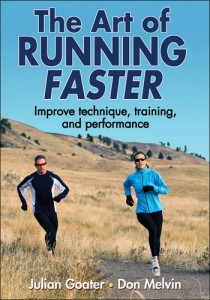When I was given the opportunity to review The Art of Running Faster by Julian Goater and Don Melvin, I was hesitant. Although I have a passion for running and am on a permanent quest to be better at it, I have tended to find books about running to be a little dry. The books have contained good factual information, but they don’t make for easy reading.
Two pages into this book, however, I was hooked. Julian Goater, the primary author, is a former elite runner from England. The advice he offers in The Art of Running Faster is liberally interspersed with anecdotes from his competition days. He gives lively accounts of races that he and his contemporaries took part in: the book artfully combines instruction with storytelling.
Goater manages to give solid advice in easy-to-understand language without talking down to his audience. He strikes a tone that is authoritative yet conversational, and while the book does seem to be geared more towards competitive athletes, there is plenty of advice for runners of all levels.
A book like this one has to meet two basic criteria in order for it to be deemed a success. First, it has engage the reader and hold his or her interest. Second, the reader has to be able to follow the advice between the covers and judge whether or not it works.
The authors have unquestionably succeeded on the first count. The material is clearly presented, the topics are covered in a way that is both informative and entertaining, and each chapter concludes with a nifty point form summary of the main topics covered.
With the first criteria met, all I had to do was test out the content of the book. In doing so, I discovered three things:
1) The advice is clearly laid out and not couched in theoretical language. Julian Goater tells runners exactly what steps to follow in order to improve things like form and hill running.
2) I didn’t have to get through most of the book before finding advice that I could act on. I was able to practice techniques I read about from the very first chapter.
3) The advice actually works. Since reading the book and using it to change various aspects of the way I run, my average long run training pace has improved by about thirty seconds per kilometre and I am no longer completely intimidated by monster hills.
This book has earned a permanent home on the “frequently read” section of my bookshelf. I have a feeling that I will read it many times, and each time I will get something new out of it.
In spite of its title, The Art of Running Faster is not only about becoming a faster runner. It is about becoming a better runner.
(Review copy and image of book cover kindly supplied by Human Kinetics)










